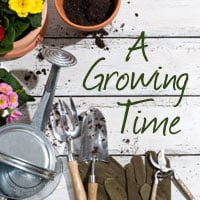Free shipping on USA orders over $129!


Spring. A time of growth. The budding leaves and blooming phlox around my house are beautiful reminders of the truth that children learn in order to grow.
Charlotte Mason believed that. Children learn in order to grow, not just to know. Growth is the goal of true education—mentally, physically, spiritually, emotionally, socially. We’ve talked a bit before about our role in helping our children grow: provide an atmosphere that welcomes growth, pull the weeds of bad habits, and feed the plant with nourishing ideas. Today, with the reminders that come with spring, let’s look at another aspect of growing.
I once heard a gardener describe a weed as a displaced plant. The same flowering bush that might be spurned in one place can be welcomed with open arms in another place. Take honeysuckle, for instance. Its fragrant flowering vines can cover unsightly walls in a garden and add beauty; but find one in a field, left to run wild, and it becomes an invasive pest.
So it is with people. What would be considered a valuable character trait when directed in the right way can become an annoying problem if left to run wild. When we think about pulling the weeds in order to help our children grow and thrive, we would do well to remember this principle.
“Every quality has its defect, every defect has its quality. Examine your child; he has qualities, he is generous; see to it that the lovable little fellow, who would give away his soul, is not also rash, impetuous, self-willed, passionate, ‘nobody’s enemy but his own’ ” (Vol. 2, pp. 67, 68).
A child who has a loving, sensitive heart may naturally consider others and try to do what will make them feel loved. But let that characteristic “go to seed,” as it were, and that child may be easily swayed from doing right because he so desperately wants to please others.
Even good traits and habits can run amuck if allowed to take the wrong direction.
The Flip Side
Now, if we think about that principle from the flip side, it will give us some direction and hope when we’re dealing with bad habits—habits we would consider weeds. When we are faced with a child’s bad habit, we can look for the corresponding good habit that has run amuck. Charlotte gave a great example of a child who had a bad habit of eavesdropping and sticking her nose into everybody else’s business.
“An Inquisitive Child.—Susie is an inquisitive little girl. Her mother is surprised and not always delighted to find that the little maid is constantly on voyages of discovery, of which the servants speak to each other as prying and poking. Is her mother engaged in talk with a visitor or the nurse—behold, Susie is at her side, sprung from nobody knows where. Is a confidential letter being read aloud—Susie is within earshot. Does the mother think she has put away a certain book where the children cannot find it—Susie volunteers to produce it. Does she tell her husband that cook has asked for two days’ leave of absence—up jumps Susie, with all the ins and outs of the case. ‘I really don’t know what to do with the child. It is difficult to put down one’s foot and say you ought not to know this or that or the other. Each thing in itself is harmless enough; but it is a little distressing to have a child who is always peering about for gossipy information.’ Yes it is tiresome, but is not a case for despair, nor for thinking hard things of Susie, certainly not for accepting the inevitable.
“The Defect of her Quality.—Regarding this tiresome curiosity as the defect of its quality, the mother casts about for the quality, and, behold, Susie is reinstated. What ails the child is an inordinate desire for knowledge, run to seed, and allowed to spend itself on unworthy objects” (Vol. 2, p. 176).
There it is. The basic “plant,” as it were, is curiosity. Allowed to run wild, it can become a bad habit. But cultivated in the right direction, it can add much enjoyment to life and motivation to learning. So Charlotte encouraged Susie’s mother to introduce some delightful topic of study to her daughter that would give her a worthy object for her curiosity. Then have a little talk about “the unworthiness of filling one’s thoughts with trifling matters so that nothing really interesting can get in” (Vol. 2, p. 177).
Every quality has its defect, every defect has its quality. Sometimes a weed is just a displaced plant.
